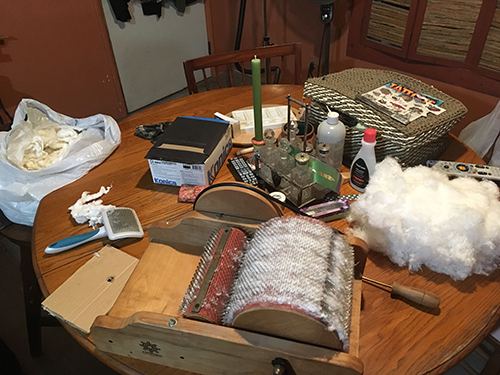
Paper has been made from cloth & rags made of cotton… so making it from raw cotton should be easy! Not quite. The Hollander beater should be able to take raw cotton and pulp it. No matter how your beater is set up or how low or high the drum and bedplate are set, the cotton will still knot up and stop your beater! You must prepare your material for a smooth knot free beating.
Since paper has historically been made from rags and natural materials (hemp, flax, etc.) I didn't think that making paper from cotton would be a big deal. Wholly Molly! I could relay all the failed attempts but, I won't. Just know that it was a 'learning' experience. My thanks to Susan Clark for donating a garbage bag full of raw cotton. I only have used 2.6 lbs. for this experiment (half the bag).
First, raw cotton has dirt, seeds, sticks and other debris in it. Heck it is a natural material. In order to clean it and pull the locks apart a bit, I built a vicious looking device used by some spinners called a 'wool-picker'. The wool picker opens the wool and prepares it for carding, combing and even spinning. It's basically opposing boards filled with sharpened nails that catch and pull apart the wool (cotton in this case). Three boards on the bottom and a sliding board on top. Click here for really rough wool-picker plans.
Click to enlarge
To use the picker, place the material at the open end (right side in the images) and place the top sliding board on top (of course) with the nails facing inward. As you slide the top board back and forth, it should drag the material (cotton in this case) into the picker and the inner nails will start to pull the material apart. By the time the material gets to the other end, it will be cleaner and more open. The dirt, seeds and other debris will fall to the bottom. You may have to do this a couple of times to really get the cotton opened up.
Picker in use
Cotton fiber needs to be "scoured" so it can be pulped in water. Raw cotton fibers contain natural oils & waxes. These need to be literally turned to soap, softening plant material and pectins so they can be washed away. Then neutralized and cleaned.
There is a fair amount of discussion about how the fiber should be "scoured". Some say use Sodium Hydroxide others soda ash or the easiest to get lye. But how much? One person bases amounts on the amount of water and another bases the amount of caustic material on the amount of natural material. You are just trying to get the material to 12.84 PH.
Here are the two different methods and my version after.
1). So my formula is 1 gallon + 2 cups of distilled water added to 3 tbs powdered Lye = 13.00 PH. A bit high but workable. Heated the water in a stainless steel pot and added 2 big handfuls to the pot and pushed it under the water with a stick. It really doesn't want to play in the water. Simmered for 1 hr. Removed and drained. That fiber is neutralized in 4.5 gallons of tap water with 2 tbs of muriatic acid (PH of 0.55, probably a bit much but workable). After 5 to 10 min in the neutralizing acid bath, it's off to 3 gallons of rinse water (PH of 8.5).
2). It took 2 days to scour 2.6 lbs. Change your water in all baths often, 'cause it can get the cotton kind of brown. If you change your water often, you won't get that. If you do, soak the material in 3 gallons of water with 2 cups 3% hydrogen-peroxide (H2O2). Note: It takes a while to dry the fiber. Sun and a fan helps the process along. I used my forced-air paper dryer to get everything dry.
 It took me about 1 week to card the 2.6 lbs of scoured cotton fiber into batts to pulp in the beater. I used a drum carder (that I borrowed from Susan Clark if I promised to fix it). The drum carder was infinitely faster than hand carding the fiber. It made batts that were 8.25" X 18.85". The finished stack of batts was close to 6' tall!
It took me about 1 week to card the 2.6 lbs of scoured cotton fiber into batts to pulp in the beater. I used a drum carder (that I borrowed from Susan Clark if I promised to fix it). The drum carder was infinitely faster than hand carding the fiber. It made batts that were 8.25" X 18.85". The finished stack of batts was close to 6' tall!
Beating the Batts
I filled the beater with 6.5 gallons of water (neutral ph). Since I do a "hydration" segment where the drum is at least 1" from the bed plate, I turned the beater on and fed in the dry batts. The cotton immediately tangled and stopped the beater. Hmmmm..... So I thought… I could: